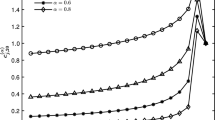Abstract
This work is dedicated to the investigation of a regularization method for the problem of determining Caputo fractional derivatives of a function in the Banach space \(L^\infty [0, T]\). This regularization method is based on the approximation of the first-order derivative of the function by the solution of a well-posed problem depending on a regularization parameter. We then discuss the Hölder type stability results for the method according to two choice rules for the regularization parameter, which are an a priori parameter choice rule and an a posteriori parameter choice rule. Some numerical examples are provided.






Similar content being viewed by others
Data Availability
Not applicable
References
Atangana, A.: Fractional operators with constant and variable order with application to geo-hydrology. Academic Press, an imprint of Elsevier, London, United Kingdom. OCLC: ocn983822604 (2018)
Hào, D.N., Liu, J., Duc, N.V., Thang, N.V.: Stability results for backward time-fractional parabolic equations. Inverse Probl. 35(12), 125006 (2019)
Duc, N.V., Muoi, P.Q., Thang, N.V.: A mollification method for backward time-fractional heat equation. Acta Math. Vietnam. 45(3), 749–766 (2020)
Hào, D.N., Duc, N.V., Thang, N.V., Thanh, N.T.: Regularization of backward time-fractional parabolic equations by Sobolev-type equations. J. Inverse Ill-Posed Probl. 28, 659–676 (2020)
Thang, N.V., Duc, N.V., Minh, L.D.N., Thanh, N.T.: Identifying an unknown source term in a time-space fractional parabolic equation. Appl. Numer. Math. 166, 313–332 (2021)
Caputo, M.: Linear models of dissipation whose Q is almost frequency independent-II. Geophys. J. Int. 13, 529–539 (1967)
Djennadi, S., Shawagfeh, N., Inc, M., Osman, M.S., Gómez-Aguilar, J.F., Arqub, O.A.: The Tikhonov regularization method for the inverse source problem of time fractional heat equation in the view of ABC-fractional technique. Phys. Scr. 96, 094006 (2021)
Murio, D.: On the stable numerical evaluation of Caputo fractional derivatives. Comput. Math. Appl. 51, 1539–1550 (2006)
Qureshi, S.: Real life application of Caputo fractional derivative for measles epidemiological autonomous dynamical system. Chaos Solit. Fractals 134, 109744 (2020)
Kilbas, A.A., Srivastava, H.M., Trujillo, J.J.: Theory and applications of fractional differential equations, no. 204 in North-Holland mathematics studies. Elsevier, Amsterdam, Boston, 1st ed., (2006)
Author information
Authors and Affiliations
Contributions
All authors contributed equally to the development of the paper.
Corresponding author
Ethics declarations
Ethical approval
Not applicable
Conflict of interest
The authors declare no competing interests.
Additional information
Publisher's Note
Springer Nature remains neutral with regard to jurisdictional claims in published maps and institutional affiliations.
Appendix A: The uniqueness theorem
Appendix A: The uniqueness theorem
Theorem A.1
(The uniqueness theorem) Problem (3) admits a unique solution in \(L^\infty [0, T]\). In addition, the solution is given by
Proof
Multiplying both side of (3) by \(\dfrac{e^{t/\beta }}{\beta }\), we get
which is equivalent to
Integrating both sides of (48) from 0 to t, we get
or
Differentiating both sides of (49) with respect to t, we obtain (4). This formula also guarantees the uniqueness of the solution. \(\square \)
Rights and permissions
Springer Nature or its licensor (e.g. a society or other partner) holds exclusive rights to this article under a publishing agreement with the author(s) or other rightsholder(s); author self-archiving of the accepted manuscript version of this article is solely governed by the terms of such publishing agreement and applicable law.
About this article
Cite this article
Duc, N.V., Nguyen, TP. A regularization method for Caputo fractional derivatives in the Banach space \(L^\infty [0, T]\). Numer Algor 95, 1033–1053 (2024). https://doi.org/10.1007/s11075-023-01598-7
Received:
Accepted:
Published:
Issue Date:
DOI: https://doi.org/10.1007/s11075-023-01598-7



